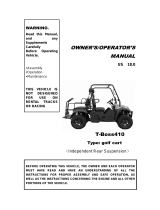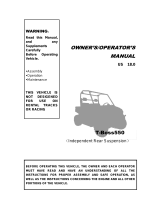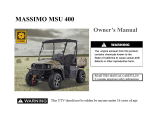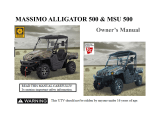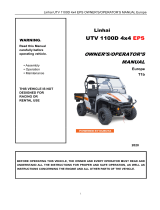Page is loading ...

SECTOR 1000
OWNER’S MANUAL
TM
GRAB SOME SUN
Published by Chongqing
Huansong Industries
(Group) Co., Ltd and
Hisun Motors Corp USA.
Chongqing Huansong
Industries (Group) Co., Ltd
and Hisun Motors Corp USA
holds the copy right.
No publishing and reprinting
without permission.
READ THIS
MANUAL CAREFULLY
For questions regarding this
UTV, please contact HISUN at:
(972)446-0760
hisunmotors.com
Rev. 07231501
No one under the age of 16
should operate this vehicle.
Provincial / Municipal
governments have dierent
regulations pertaining to
owning and operating an
o-road vehicle; learn the
regulations in your area.

Introduction HS 1000
1-1
INTRODUCTION
Congratulations on your purchase of the HS 1000 UTV. This Owner’s / Operator’s manual will
provide you information regarding safe operation, operational instructions, maintenance and
care. Fully understanding and following all of the instructions in this manual will provide the
knowledge needed to have safe operation and longevity of the UTV.
For questions regarding this UTV, please call (972) 446-0760.
IMPORTANT SAFETY MESSAGES
●READ THIS MANUAL CAREFULLY AND COMPLETELY BEFORE OPERATING YOUR UTV.
MAKE SURE YOU UNDERSTAND ALL INSTRUCTIONS.
●PAY CLOSE ATTENTION TO THE WARNING AND CAUTION LABELS ON THE UTV.
●NEVER OPERATE THE UTV WITHOUT PROPER TRAINING OR INSTRUCTION.
●THIS UTV SHOULD NOT BE RIDDEN BY ANYONE UNDER 16 YEARS OF AGE.

Introduction HS 1000
1-2
IMPORTANT MANUAL INFORMATION
FAILURE TO FOLLOW THE WARNINGS CONTAINED IN THIS MANUAL CAN RESULT IN SERIOUS
INJURY OR DEATH.
Particularly important information is distinguished in this manual by the following
notations:
The Safety Alert Symbol means ATTENTION!
YOUR SAFETY IS INVOLVED!
Failure to follow WARNING instructions could result in severe injury or death to
the machine operator, bystander or a person inspecting or repairing the
machine.
A CAUTION indicates special precautions that must be taken to avoid damage
to the machine.
NOTE:
A NOTE provides key information to make procedures easier clearer.

Introduction HS 1000
1-3
IMPORTANT NOTICE
This UTV is designed and manufactured for OFF - ROAD use only. It is illegal and unsafe to operate this
UTV on any public street, road or highway.
This UTV complies with all applicable OFF - ROAD noise level and spark arrester laws and regulations in
effect at the time of manufacture.
Please check your local riding laws and regulations before operating this UTV.
When the temperature is below -4°F (-20°C), park the UTV in a place where the temperature is higher
than -4°F (-20°C). Operate the UTV after the UTV has warmed up. Please see page 7-3 on the warming
up process.
Follow the proper parking procedures when the temperature is higher than 100°F (38°C): turn off the
engine; make sure the radiator fan is on for 3 minutes before turning off the power switch.
Starting the UTV for the first time will take longer because the fuel will need reach the fuel injectors. To
start the UTV the first time, hold the ignition key on at 5-second intervals. Allow the starter to rest 15
seconds between each start attempt.

Introduction HS 1000
1-4
Table of Contents
Subject
Introduction
Warnings Cautions and Notes
Important Notice
Table of Contents
Part Locations
Part Locations
Part Locations
Safe Operation
Safety Instructions
Operation
Children Safety Instructions
Driving on a slope
Driving at high speed
Instructions for carrier
Parking
Transportation
Maintenance
Warning and Caution Labels
Identification Numbers
Pre-Operation Check
Starting the Engine
Display Warning Lamps
Stopping the Engine
Operating the vehicle
Headlight switch
Hazard switch
Turn Signal switch
Brake Pedal
Gear Shift Lever
Parking Brake
Accelerator Pedal
Fuel Gauge
Coolant Temperature
Hour Meter, Speedometer
Maintenance
Service Intervals
Periodic Service
Hood, Seat, Cargo Bed
Jack positioning
Daily check
Fuel Tank
Engine Oil
Coolant Level
Parking Brake
Checking CV Boots
50 Hour check
Page
1-1
1-2
1-3
1-4
2-1
2-2
2-3
2-4
2-4
2-5
2-5
2-6
2-6
2-6
2-7
2-7
2-7
2-8
3-1
4-1
4-2
4-3
4-4
4-5
4-6
4-6
4-6
4-7
4-7
4-8
4-8
4-9
4-9
4-10
5-1
5-1
6-1
6-1
6-2
6-3
6-3
6-3
6-3
6-5
6-6
6-6
Subject
Wheel bolt torque
Cleaning the air filter
Evacuator valve
Battery condition
Battery Charging
Storage instructions
Adjusting Toe-In
Cleaning the Spark
arrester
200 hour check
Changing Engine oil
Replacing engine oil
filter
Checking the Brake
pedal stroke
Radiator hoses and
clamps
Precautions at
overheating
Checking Intake air line
300 Hour check
Checking the tires
500 Hour check
600 Hour Check
1500 Hour check
Every year check
Every 2 years check
Antifreeze
Every 4 years check
Replacing Mini Fuses
Replacing Light bulbs
Specification Table
Traveling Speeds
Vehicle Limitations
EPS System
Storage
Removing the vehicle
from storage
Troubleshooting Engine
Diagnostic Trouble
Codes
Battery Troubleshooting
Vehicle Troubleshooting
Options
Winch Mount Plate
Emissions Warranty
Page
6-7
6-8
6-8
6-9
6-9
6-10
6-10
6-11
6-11
6-11
6-11
6-12
6-12
6-13
6-13
6-13
6-13
6-14
6-14
6-14
6-14
6-15
6-15
6-17
6-17
6-17
7-1
7-2
7-3
8-1
9-1
9-2
10-1
10-2
10-3
10-4
11-1
12-1
13

General
2-4
All operators, including experienced, should
carefully read and fully understand this Users
Manual. Operation as directed in this manual
should be strictly adhered to in order to achieve
the best performance and avoid accidents.
Others who use your UTV should be trained on
how to operate the UTV and read this manual
before operation.
Safety Instructions:
1. Understand this UTV by reading this manual
and understanding all the components of the
vehicle. Only start and operate the vehicle
after finishing reading this manual.
2. Pay close attention to the warning and
caution labels on the UTV.
3. Understand completely and learn to use the
safety devices (roll-over protective structure,
seat belts), and never change the original
safety devices. If safety devices are
damaged, consult your local dealer for
replacement. Always use seat belts.
① Roll-over protective structure;
② Seat belts
4. Do not wear loose articles of clothing during
operation, as these can be drawn into
moving parts on the vehicle and could cause
a severe injury to occur.
5. You should always wear protective
equipment, such as helmet, boots, eye
protection, ear protection, and gloves etc.
6. Only a qualified driver with driving license
should operate this UTV. Never operate
after drinking, using drugs or controlled
products, or while fatigued.
Always perform the pre-operation checks as
following:
1) Check seat belt for wear or damage, if
necessary, replace it.
2) Check brakes, throttle, brake pedal and
other mechanical parts for proper
operation. If you discover any
irregularities, replace related parts as
necessary. Periodically check the fittings
and fasteners.
3) Check engine oil level and engine
coolant level.
4) Check that the UTV is equipped to
handle the surroundings.
5) Check and keep vehicle clean. Sludge,
grease and debris can cause a fire and
severe injury.
7. Passenger quantity and loading:
1) Only the driver and one passenger inside
cab. It is suggested that children under
age of 5 not be allowed as a passenger.
2) Single-row vehicle’s loading limit is
660lbs (300KG). Reduce the loading
weight according to road conditions.
Never exceed the weight limits for
operation.
3) Never allow unauthorized persons to
repair this UTV. This may affect vehicle
performance and cause injury.
SAFE OPERATION

General
2-5
2. Operation
1. Start the engine only in an open ventilated
area. Carbon monoxide is colorless, odorless
and is emitted from the engine and can
cause death in areas with poor ventilation.
2. Never start the vehicle or operate the gear
selector unless seated in the driver’s seat.
3. Never start the engine until the select lever is
placed in “N” position and the brake is in the
brake position.
4. The driver and passenger shall always wear
their seatbelt while the vehicle is being
operated.
5. Operators of the UTV should not wear
earphones.
6. Use the proper trailer hitch to haul cargo,
otherwise, serious injury or death can
happen.
① Trailer Hitch
7. Do not accelerate quickly when starting the
engine, especially driving on rough terrain as
this can cause injury or death. Press the
accelerator pedal slowly.
8. Drive at slow speeds before braking.
9. With the differential unlocked (DIFF.LOCK is
off) the front/rear wheels can turn at different
speeds to assist in the stability of the vehicle.
10. Never drive over terrain such as a ditch, a
hole, dams, excessive mud, or the vehicle
can get stuck because of the vehicles
weight.
11. Always pay close attention to your
surroundings, and check for streets, trail
intersections or other obstacles.
12. Always use signals in advance of turns.
13. Do not allow entrance or exit of the vehicle
while it is moving.
14. Keep the floorboard free of debris that can
obstruct the ability to use the brake pedal.
15. Position your hands on the steering wheel.
Always keep your hands and feet inside
passenger area of the vehicle. Never try to
stand while operating the vehicle.
16. Do not tow passengers, or attempt to jump
the vehicle.
Children safety instructions
Always watch children when they are around the
vehicle. Children like to imitate adults and this
could lead to an accident.
Do not leave children alone beside the vehicle.
Keep children from the operating area of the
vehicle.
Turn off the engine and remove the key when
children are in the operating area.
Never carry children in the cargo area. This is
very dangerous to children. Children under age
of 5 should not be allowed in this vehicle.
Never allow children to touch or climb on the
vehicle, even if they are under adult supervision.
Always check for people or obstacles behind the
vehicle before shifting the vehicle into reverse.
Avoid a collision with an obstacle or person.
Park the vehicle on a firm, flat area. If parking
on a slope, you should use hand lever parking
brake, remove the key.

General
2-6
Parking
1. Set the gear shift to the “N” position and pull
the braking brake to the top position to park
the vehicle.
2. Avoid stopping the vehicle on a slope. If
stopping on a slope make sure the vehicle is
stationary before exiting.
① Parking Brake foot lever.
Transportation
1. Avoid dragging the vehicle behind another
vehicle. Use a trailer or truck to transport the
vehicle.
2. When loading or unloading, pay attention to
your surroundings and others in the area.
Maintenance
Stop the vehicle and park it on level ground. Pull
the parking brake and remove all cargo. Place
the shift lever in the “N” position, stop the engine
and remove the key.
1. When working next to the engine, exhaust,
or radiator, work only after it has cooled
down.
2. Wait for the engine to stop running and cool
down before checking the coolant level.
Otherwise, you could be burned by hot fluid
or steam.
3. No smoking when adding electrolyte or
refueling. Fuel tank and battery should be
kept away from sparks. Battery produces
hydrogen and oxygen in charging and this
could accelerate the risk of explosion.
4. Read and follow the instructions before
replacing the battery.
5. During maintenance, first aid kits and fire
extinguishers should be placed at your
fingertips.
6. During maintenance, you should disconnect
the battery cables.
① Battery
7. Do not open radiator cap before coolant
has cooled down. Open the cap slowly and
let the coolant pressure reduce, and then
open the radiator cap fully to remove.
Check for the coolant level in the coolant
reservoir. If necessary, add coolant.
8. Tires should be mounted on rims with
special equipment, only by professionals.
9. Keep the specified tire pressure to ensure
driving safety.
10. Elevate the vehicle and place a suitable
stand under the frame when removing the
wheels. Be sure to re-tighten the wheel nuts
to the specified torque.

Identification Numbers
3-1
Your dealer is interested in your new vehicle and
has the desire to help you get the most value from
it. After reading this manual thoroughly, you will
find you can do some of the regular maintenance
by yourself.
However, when in need of parts or major service,
be sure to see your dealer.
For service, contact the dealership from which you
purchased your vehicle or your local dealer.
When in need of parts, be prepared to give your
dealer both the vehicle and engine serial numbers.
Locate the serial numbers now and record them in
the space provided.
Type
Serial Number
Vehicle
Engine
Date of Purchase
Name of Dealer
Vehicle serial number.
Engine serial number

Maintenance
5-1
CAUTION:
To avoid personal injury and vehicle damage:
Be sure you have sufficient knowledge, experience, the proper replacement parts and
tools before you attempt any vehicle maintenance task.
If you don’t have the knowledge and equipment which are necessary to perform the
maintenance task, consult your local dealer.
Have your local dealer perform inspection items which are marked *4 in the chart below.
SERVICE INTERVALS
IMPORTANT:
The jobs indicated by ◎ must be done after the first 50 hours of operation.
*1 Air cleaner should be cleaned more often in dusty conditions than in normal conditions.
*2 Every year or every 6 times of cleaning.
*3 Replace only if necessary.
*4 Consult your local dealer for this service.
*5 When the battery is used for less than 100 hours per year, check the battery condition by reading
the indicator annually.
The items listed below (*marked) are registered as emission related critical parts by DEALER in
the U.S.EPA non road emission regulation. As the engine owner, you are responsible for the
performance of the required maintenance on the engine according to the below instruction.
Please see Warranty Statement in detail.
No.
Items
Indication of
After
700 hrs
50
100
150
200
250
300
350
400
450
500
550
600
650
700
1
Engine oil
Change
◎
○
○
○
Every
200 hrs
2
Engine oil filter
Replace
◎
○
○
○
Every
200 hrs
3
Transmission
fluid
Change
○
Every
400 hrs
4
Engine start
system
Check
○
○
○
○
○
○
○
○
○
○
○
○
○
○
Every
50 hrs
5
Greasing
Apply
○
○
○
○
○
○
○
○
○
○
○
○
○
○
Every
50 hrs
6
Muffler
Clean
◎
○
○
○
○
○
○
○
Every
100 hrs
7
Spark arrester
Clean
○
○
○
○
○
○
○
Every
100 hrs
8
Wheel bolt
torque
Check
◎
○
○
○
○
○
○
○
Every
100 hrs
9
Battery condition
Check
○
○
○
○
○
○
○
Every
100 hrs
10
Toe-in
Adjust
○
○
○
○
○
○
○
Every
100 hrs

Maintenance
5-2
No.
Items
Indication of
After
700 hrs
50
100
150
200
250
300
350
400
450
500
550
600
650
700
11
*Fuel filter
element
Check
○
○
○
○
○
○
○
Every
100 hrs
Replace
○
Every
100 hrs
12
*Fuel line
Check
○
○
○
○
○
○
○
Every
500 hrs
Replace
Every
100 hrs
13
*Air cleaner
element
Clean
○
○
○
○
○
○
○
Every 1
years
Replace
Every
100 hrs
14
Brake pedal
Check
◎
○
○
○
Every 1
years
15
Parking brake
lever
Adjust
◎
○
○
○
Every
200 hrs
16
Brake light
switch
Check
◎
○
○
○
Every
200 hrs
17
Radiator hose
and clamp
Check
○
○
○
Every
200 hrs
Replace
Every 2
years
18
*Intake air line
Check
○
○
○
Every
200 hrs
Replace
Every 1
years
19
Brake hose &
lines
Check
◎
○
○
○
Every
200 hrs
Check
Every 4years
20
Tire wear
Check
◎
○
○
Every
300 hrs
21
Front axle case
oil
Change
○
Every
400 hrs
22
Knuckle case
oil
Change
○
Every
400 hrs
23
Engine valve
clearance
Adjust
Every
800 hrs
24
*Fuel injection
Check
Every
1500 hrs
25
*Injection
Check
Every
3900 hrs
26
Brake fluid
Change
Every 2
years
27
Remote
hydraulic hose
Replace
Every 2
years
28
Rear brake
cylinder seal
Replace
Every 2
years
29
Front brake
seal
Replace
Every 2
years

Maintenance
5-3
No.
Items
Indication of
After
700 hrs
50
100
150
200
250
300
350
400
450
500
550
600
650
700
30
Cooling system
Flush
Every 2
years
31
Coolant
Change
Every 2
years
32
Fuel system
Bleed
Service as
required
33
Fuse
Replace
Service as
required
34
Light bulb
Replace
Service as
required
NOTE:
◆ Engine Oil:(15W/40SL)
Oil used in the engine should have an American Petroleum Institute (API) service classification and
Proper SAE Engine Oil according to the ambient temperatures as shown above.
◆ Brake fluid:
Always use DOT3 GENUINE BRAKE FLUID from a sealed container.

Operating the Vehicle
4-1
Pre-Operation Check
DAILY CHECK
To better prevent troubles, it is important to know the condition of the vehicle, before operating.
Check it before starting.
CAUTION:
To avoid personal injury:
Be sure to check and service the vehicle on a level surface with the engine shut off, the
parking brake “ON”, and implements lowered to the ground if equipped.
Check items
-Visually inspect the exterior of the vehicle
-Check engine oil level
-Check transmission oil level
-Check brake fluid level
-Check coolant level
-Clean radiator screen
(When used in dusty areas)
-Check brake and pedal
-Check parking brake
-Check indicators, gauges and meters
-Check lights
-Check seat belts and roll-over protective structures.
-Check front and rear joint boots.
-Check tire inflation pressure.
-Check backup beeper (if equipped).
-Refuel
(See "PRE-OPERATION CHECK" in "PERIODIC SERVICE" section.)
-Check danger, warning and caution labels
(See "DANGER, WARNING AND CAUTION LABELS"in"SAFE OPERATION"section.)

Operating the Vehicle
4-2
CAUTION:
To avoid personal injury:
Read "SAFE OPERATION" in front of this
manual.
Read the danger, warning and caution
labels located on the vehicle.
To avoid the danger of exhaust fume
poisoning, do not operate the engine in
closed buildings without proper
ventilation.
Start engine only from the operator’s
seat. Never start the engine while
standing on ground.
Make it a rule to set gear shift lever to
“NEUTRAL” position before starting the
engine.
IMPORTANT:
Do not use starting fluid or ether.
To protect the battery and the starter, make
sure that the starter is not continuously
turned for more than 5 seconds.
STARTING THE ENGINE
1. Make sure the parking brake is set.
① Parking brake lever
NOTE:
The parking brake warning lamp (P) comes on
while parking brake is applied and goes off when
it is released.
① Parking brake warning lamp

Operating the Vehicle
4-3
2.
Set gear shift lever to the “NEUTRAL”
position.
① Gear shift range lever.
(L) Low Range
(H) High Range
(N) “Neutral” position
(R) “REVERSE”
3. Push the accelerator pedal down about 1/2
way.
① Accelerator pedal
② “INCREASE
③ “DECREASE
1. Insert the key into the key switch and turn it
to “START”.
OFF (Engines stop)
ON (Engine run or headlight on)
START (Engine start)
◆Display Warning Lights
1. When the key is turned to “START”, lamps (1
engine oil pressure) should come on. If
trouble occurs at any location with engine
running, the warning lamp corresponding to
that location comes on.
2. The parking brake warning lamp (2 parking
brake) comes on while parking brake is
applied and goes off when it is released.
/







